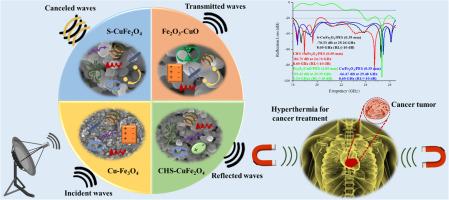相组成或材料形态,其中一个在促进微波吸收和热疗中起着先锋作用
IF 7.1
Q1 ENGINEERING, CHEMICAL
引用次数: 0
摘要
形态学和相位控制使微波吸收、热疗和光学特性的调谐变得更好。材料的相和形态决定了基本因素,包括磁导率、介电常数、阻抗匹配、磁性能和光学性能。每一相的性质分别决定了其磁导率和介电常数的微波吸收性能。同时,基于本征特性、尺寸和形貌特性的成核相及其改性,通过改善极化松弛损耗、磁性能、阻抗匹配、超材料特性、多次反射和散射、微电流和导电网络,为微波衰减铺平了道路。在热疗方案中,晶体相提供了开创性的磁性性能,如饱和磁化和矫顽力;另一方面,基于Snoek极限和调节自旋钉钉、晶体缺陷和不饱和坐标态的形貌表明了磁性特征,优化了热疗性能。优化这些特征可以显著提高微波吸收和热疗性能。本文通过对CuFe2O4结构的形貌进行调控,利用创新的前驱体和合成途径,将Cu、CuO、Fe2O3和Fe3O4等多种晶相加载到结构中。为了制备最终的复合材料,采用聚醚砜(PES)作为极化吸波介质,调节其微波吸收和屏蔽性能。经相位修饰后的样品(Fe2O3/CuO/PES)在25.35 GHz处的反射损耗(RL)为-95.43 dB,有效带宽为3.24 GHz,厚度为1.95 mm。特别是,经过形貌修饰的CuFe2O4/PES覆盖了厚度为0.35 ~ 0.75 mm的k波段。雷达截面(RCS)结果表明,相和形貌的改变提高了样品的隐身性能。在33度角时,RCS降低了37.61 dBm²。更重要的是,构建的样品在热疗中表现出相当大的电磁干扰屏蔽效果(EMI SE)和特定吸收率。本文章由计算机程序翻译,如有差异,请以英文原文为准。

Phase composition or material morphology, which one plays the pioneering role in promoting microwave absorption and hyperthermia
Morphology and phase control have enabled better tuning of microwave absorbing, hyperthermia, and optical characteristics. The phase and morphology of materials determine fundamental factors, including permeability, permittivity, impedance matching, magnetic properties, and optical performance. The nature of each phase individually determines microwave absorption performance based on its permeability and permittivity. Meanwhile, nucleated phases and their modification, based on intrinsic characteristics, as well as size and morphology properties, by improving polarization-relaxation loss, magnetic properties, impedance matching, metamaterial characteristics, multiple reflections and scatterings, microcurrents, and conductive networks, pave the way for microwave attenuation. In the hyperthermia scenario, the crystalline phase offers pioneering magnetic performances such as saturation magnetization and coercivity; on the other hand, the morphology based on the Snoek limit and regulated spin pinning, crystal defect, and unsaturated coordinate states suggests the magnetic characteristics and optimizes the hyperthermia performance. Optimizing these features can significantly improve microwave absorption and hyperthermia performance. Here, the morphology of the CuFe2O4 structure was manipulated, and various crystalline phases, including Cu, CuO, Fe2O3, and Fe3O4, were loaded into the structure using innovative precursors and synthetic routes. To fabricate the final composite, polyethersulfone (PES) was used as a polarizable microwave-absorbing medium, thereby regulating the microwave absorption and shielding performance. The phase-modified sample (Fe2O3/CuO/PES) demonstrated the highest reflection loss (RL) of -95.43 dB at 25.35 GHz and an effective bandwidth of 3.24 GHz, with a thickness of 1.95 mm. Particularly, morphology-modified CuFe2O4/PES covered the k-band with a thickness ranging from 0.35 to 0.75 mm. The radar cross sections (RCS) results demonstrated that the phase and morphology modification promoted the cloaking capability of the samples. An impressive RCS reduction of 37.61 dBm² was achieved at an angle of 33 degrees. More importantly, the architected samples demonstrated considerable electromagnetic interference shielding effectiveness (EMI SE) and specific absorption rate in hyperthermia therapy.
求助全文
通过发布文献求助,成功后即可免费获取论文全文。
去求助
来源期刊

Chemical Engineering Journal Advances
Engineering-Industrial and Manufacturing Engineering
CiteScore
8.30
自引率
0.00%
发文量
213
审稿时长
26 days
 求助内容:
求助内容: 应助结果提醒方式:
应助结果提醒方式:


